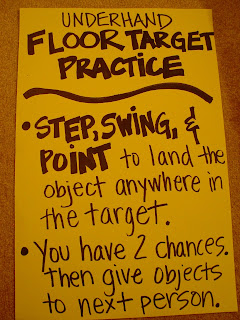Sometimes we play games at the beginning or end of class for warm-up or cool-down. These games often are low-organization games, which don't involve assigned positions or long sets of rules. Both warm-up and cool-down games usually are designed to get students moving. For cool-down games, we try to select ones that are relatively calm to prepare students to transition to their next special or to their classroom.


Here are two photos of 3rd and 4th grade students playing a version of
Rock, Paper, Scissors called
"I won, We Run" as a warm-up game. Students gather around the center line of the gym, all with a partner to play Rock, Paper, Scissors. They play. The winner runs to touch the black endline once. The loser runs to touch the black line twice. Once each player returns to the center line, they play against anyone else who is ready to play. Ties play again until someone is the winner.
Another favorite is our
Spelling Warm-Up. Each student has a card with a word on it. All students start in the center circle, holding their card. They jog to touch the wall underneath each letter to spell their card word. They then exchange their card for a new card. Letters are on the gym wall in ABC order. This activity not only gets students moving, but also reinforces alphabetical order skills.
 |
| W is for Warm-up! Letters like this are posted around the perimeter of the gym. We use them for the Spelling Warm-Up described above, and they also are used for one of our assigned seats in the gym. |
Everybody's It. Everybody
LOVES this one! This is great for a cool-down since it is more calm, even though students LOVE it. Just like the game's title sounds,
everyone is it for this one. Students have to stay inside the boundary line we call "the box", the black line marking the perimeter of the basketball court lines.
Walking only.
- Round 1: If you get tagged by anyone, you sit down criss-cross-applesauce and you are out. You sit immediately right where you were tagged. No moving your seat, no turning your body around, no getting back into the game.
If Round 1 is played perfectly (no reminders about how to sit!), and we have time, we try the following variation for the subsequent round:
- Round 2: If you get tagged by anyone, you sit down criss-cross-applesauce. You sit immediately right where you were tagged. No moving your seat, no turning your body around, no getting back into the game. This time: You can tag others while sitting. If you tag others while sitting down, they sit down where you tagged them. You may not uncross your legs or lay down.
If Round 2 is played perfectly (no reminders about how to sit or unfolding legs/laying down!), and we have time, we try the following variations for one more round:
- Round 3: If you get tagged by anyone, you sit down criss-cross-applesauce. You sit immediately right where you were tagged. No moving your seat, no turning your body around, no getting back into the game. This time: You can tag others while sitting. If you tag another person while sitting down, they sit down where you tagged them, AND YOU GET BACK UP. You are back in the game.
Hot Lava. We imagine the three center circles are full of hot lava. Stay out of the lava! Go counterclockwise around the gym using different locomotor skills. I usually participate with students (which explains why many days, I wear shorts, even in cold weather!). I demonstrate each locomotor skill, calling out the skill with the microphone while we are all moving. We turn the music up, and students are encouraged to sing along! This activity really gets our hearts and muscles warmed up.



















